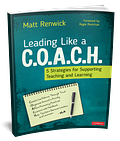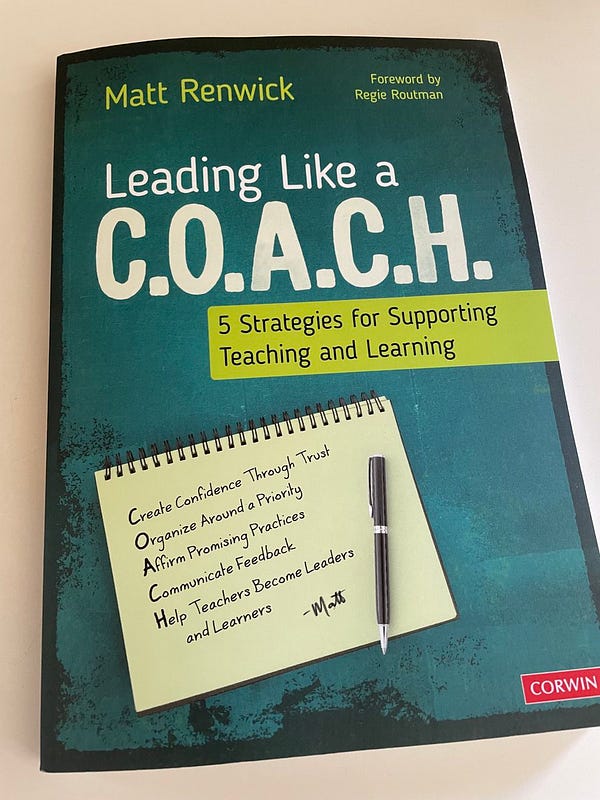This adapted excerpt from my new book, Leading Like a C.O.A.C.H., questions the tendency for educators to seek fail-safe instructional practices in a search for certainty.
During a conversation I once had with a district administrator about adopting a scripted curriculum program, one of their arguments for the resource was that it was based on “best practice”.
This stance invites resistance. Educational researcher Dr. Viviane Robinson notes that “appeals to adopt ‘best practice’ imply that current practice is less than best, and such implicit evaluations are more likely to generate mistrust and suspicion than enthusiasm for change” (2018, pg. 39).
Related, who gets to determine what a “best practice” is in education? Education is evolving, considering new research, changing environments, and technology. As a colleague of mine noted, “If someone has figured out the best way to teach, everyone would be doing it and education would be fixed.” This stance leads to a raft of problems, including retroactive guilt teachers might feel from previous teaching decisions and the difficult argument one tries to make in defending their practice.
Both issues surface the reality that teaching is dynamic and holds too many variables to ever deem one teaching practice, resource, or strategy as the epitome of our profession. There will be scenarios in which almost any teaching practice situated in a specific classroom fails to help students learn. For example, feedback may have less of an impact if a relationship has not first been established between teacher and student, or the goal for a lesson has not been clearly articulated.
This example confirms the theory of practice described in this very book: that every school already has the professional capacity to address their unique challenges. And yet the last thing I would proclaim to one reader is to follow this theory to a “T”. No one can possibly know with certainty how teachers will respond to these strategies in a school. While there is “nothing more practical than a good theory”, it is only as effective as its flexibility and adaptability to unique situations. Yes, trust is a foundation for this work. Yes, it is hard to move forward together without some type of priority. Yet trust can be fostered in a myriad of ways. Every school has its own specific needs to prioritize around.
So instead of developing the typical plan, breaking it down into objectives, and following a linear process to success, we can instead remain somewhere between curiosity and certainty by focusing on promising practices in the classroom and how we as leaders can affirm them when we see them during instructional walks.
Three Tenets of Promising Practices
“Promising practices” strikes me as the right balance between confidence in our classroom practice and remaining open to new ways of instruction. It is a paradox of belief: that we have both trust in ourselves and curiosity toward other possibilities.
With that, what makes a practice promising? I see three criteria.
1. The practice is aligned with the district’s vision and a school’s shared beliefs. It is important that whatever teaching strategy, method or approach is employed schoolwide, that it is coherent with what the faculty believe to be true. For example, in our school we believe that phonemic awareness can be taught with students’ own writing. That does not preclude a teacher from using direct instruction of phonics. But if isolated skill development is the only way in which phonemic awareness is developed with students, then that is not a promising practice. Word study removed from an authentic context is not aligned with our beliefs.
2. The practice has evidence to support its effectiveness. As a professional, we must look to current research to make an informed decision about what practices enter our curriculum and classrooms. Dr. John Hattie (2021) offers a list of the most effective practices (visiblelearning.com) based on a summary of many studies on each approach at his Visible Learning website. Any practice that is considered promising should also have evidence that is peer reviewed and independently evaluated; the publisher or company was not involved in the study of its effectiveness.
3. There are situations in which the practice may be ineffective. This rule would seem to apply to almost any practice in education. For example, summarization has a high impact on student learning. But what text or content are the students being asked to summarize? Is it relevant to their lives, or simply a generic passage assigned by the teacher to address a standard? Further, were students able to select the information to summarize, as motivation also has an impact? In addition, did the teacher engage in some type of shared demonstration of summarization prior to releasing the responsibility? Implementing a promising practice is not like taking a pill prescribed to you by your doctor; the nuances and variables of teaching and learning are too great to accept any practice as infallible.
So how can we find agreement on anything? By leading like a coach and affirming the process of teaching and learning: noticing and naming what is going well and getting curious about where we might seek improvement.
What others are saying about the book:
“This is a book all leaders should read. It could be transformational.”
- Kelly Jones, instructional coach, Madison Metropolitan School District



















What do you mean by "best practice"?